The Influence of Winglet Pitching on the Performance of a Model Wind Turbine: Aerodynamic Loads, Rotating Speed, and Wake Statistics
Abstract
1. Introduction
2. Experimental Setup
3. Results and Discussion
3.1. Rotation Speed and Thrust Force
3.2. Wake Characteristics
4. Conclusions
Author Contributions
Funding
Acknowledgments
Conflicts of Interest
References
- Electricity in the United States-Energy Explained, Your Guide To Understanding Energy (EIA, 2019). Available online: https://www.eia.gov/energyexplained/index.cfm?page=electricityintheunitedstates (accessed on 3 January 2020).
- Cost and Performance Characteristics of New Generating Technologies, Annual Energy Outlook 2019. U.S. Energy Information Administration. Available online: https://www.eia.gov/outlooks/aeo/assumptions/pdf/table_8.2.pdf (accessed on 3 January 2020).
- Barthelmie, R.; Hansen, O.F.; Enevoldsen, K.; Højstrup, J.; Frandsen, S.; Pryor, S.; Larsen, S.; Motta, M.; Sanderhoff, P. Ten years of meteorological measurements for offshore wind farms. J. Sol. Energy Eng. 2005, 127, 170–176. [Google Scholar] [CrossRef]
- Pryor, S.C.; Barthelmie, R.J. Flow characteristics in the coastal zone. In European Seminar Offshore Wind Energy in Mediterranean and Other European Seas; ENEA: Paris, France, 2000; pp. 29–43. [Google Scholar]
- Akpinar, E.K.; Akpinar, S. An assessment on seasonal analysis of wind energy characteristics and wind turbine characteristics. Energy Convers. Manag. 2005, 46, 1848–1867. [Google Scholar] [CrossRef]
- Gökçek, M.; Bayülken, A.; Bekdemir, S. Investigation of wind characteristics and wind energy potential in Kirklareli, Turkey. Renew. Energy 2007, 32, 1739–1752. [Google Scholar] [CrossRef]
- Guo, H.; Xu, M.; Hu, Q. Changes in near-surface wind speed in China: 1969–2005. Int. J. Climatol. 2011, 31, 349–358. [Google Scholar] [CrossRef]
- Ouammi, A.; Dagdougui, H.; Sacile, R.; Mimet, A. Monthly and seasonal assessment of wind energy characteristics at four monitored locations in Liguria region (Italy). Renew. Sustain. Energy Rev. 2010, 14, 1959–1968. [Google Scholar] [CrossRef]
- Tobin, N.; Zhu, H.; Chamorro, L.P. Spectral behaviour of the turbulence-driven power fluctuations of wind turbines. J. Turbul. 2015, 16, 832–846. [Google Scholar] [CrossRef]
- Jin, Y.; Liu, H.; Aggarwal, R.; Singh, A.; Chamorro, L.P. Effects of freestream turbulence in a model wind turbine wake. Energies 2016, 9, 830. [Google Scholar] [CrossRef]
- Liu, H.; Jin, Y.; Tobin, N.; Chamorro, L.P. Towards uncovering the structure of power fluctuations of wind farms. Phys. Rev. E 2017, 96, 063117. [Google Scholar] [CrossRef]
- Liu, H.; Hayat, I.; Jin, Y.; Chamorro, L. On the evolution of the integral time scale within wind farms. Energies 2018, 11, 93. [Google Scholar] [CrossRef]
- Hau, E. Commercial Applications of Wind Turbines. In Wind Turbines: Fundamentals, Technologies, Application, Economics; Springer Science & Business Media: Munich, Germany, 2006; pp. 563–614. [Google Scholar]
- Nagai, B.M.; Ameku, K.; Roy, J.N. Performance of a 3 kW wind turbine generator with variable pitch control system. Appl. Energy 2009, 86, 1774–1782. [Google Scholar] [CrossRef]
- Muljadi, E.; Butterfield, C.P. Pitch-controlled variable-speed wind turbine generation. IEEE Trans. Ind. 2001, 37, 240–246. [Google Scholar] [CrossRef]
- Gao, R.; Gao, Z. Pitch control for wind turbine systems using optimization, estimation and compensation. Renew. Energy 2016, 91, 501–515. [Google Scholar] [CrossRef]
- Van Wingerden, J.W.; Hulskamp, A.W.; Barlas, T.; Marrant, B.; van Kuik, G.A.M.; Molenaar, D.P.; Verhaegen, M. On the proof of concept of a ‘smart’ wind turbine rotor blade for load alleviation. Wind Energy 2008, 11, 265–280. [Google Scholar] [CrossRef]
- Barlas, T.K.; Van Kuik, G.A.M. Review of state of the art in smart rotor control research for wind turbines. Prog. Aerosp. Sci. 2010, 46, 1–27. [Google Scholar] [CrossRef]
- Barlas, T.K.; Van der Veen, G.J.; Van Kuik, G.A.M. Model predictive control for wind turbines with distributed active flaps: Incorporating inflow signals and actuator constraints. Wind Energy 2012, 15, 757–771. [Google Scholar] [CrossRef]
- Whitcomb, R.T. A Design Approach and Selected Wind Tunnel Results at High Subsonic Speeds for Wing-Tip Mounted Winglets; NASA TN D-8260; Natl. Aeronaut. Space Admin: Washington, DC, USA, 1976.
- Johansen, J.; Sørensen, N.N. Aerodynamic Investigation of Winglets on Wind Turbine Blades Using CFD Risø-R-1543(EN); Risø National Laboratory: Roskilde, Denmark, 2006. [Google Scholar]
- Imamura, H.; Hasegawa, Y.; Kikuyama, K. Numerical analysis of the horizontal axis wind turbine with wihglets. JSME Int. J. Ser. B Fluids Therm. Eng. 1998, 41, 170–176. [Google Scholar] [CrossRef]
- Gaunaa, M.; Johansen, J. Determination of the maximum aerodynamic efficiency of wind turbine rotors with winglets. J. Phys. Conf. Ser. 2007, 75, 012006. [Google Scholar] [CrossRef]
- Saravanan, P.; Parammasivam, K.M.; Selvi Rajan, S. Pressure distribution of rotating small wind turbine blades with winglet using wind tunnel. J. Sci. Ind. Res. 2012, 71, 425–429. [Google Scholar]
- Saravanan, P.; Parammasivam, K.M.; Selvi Rajan, S. Experimental investigation on small horizontal axis wind turbine rotor using winglets. J. Eng. Appl. 2013, 16, 159–164. [Google Scholar]
- Belferhat, S.; Meftah, S.M.A.; Yahiaoui, T.; Imine, B. Aerodynamic Optimization of a Winglet Design. In EPJ Web of Conferences; EDP Sciences: Paris, France, 2013; Volume 45, p. 01010. [Google Scholar]
- Tobin, N.; Hamed, A.M.; Chamorro, L.P. An Experimental Study on the Effects ofWinglets on the Wake and Performance of a ModelWind Turbine. Energies 2015, 8, 11955–11972. [Google Scholar] [CrossRef]
- Zhu, B.; Sun, X.; Wang, Y.; Huang, D. Performance characteristics of a horizontal axis turbine with fusion winglet. Energy 2017, 120, 431–440. [Google Scholar] [CrossRef]
- Khaled, M.; Ibrahim, M.M.; Hamed, H.E.A.; AbdelGwad, A.F. Investigation of a small Horizontal–Axis wind turbine performance with and without winglet. Energy 2019, 187, 115921. [Google Scholar] [CrossRef]
- Mühle, F.; Bartl, J.; Hansen, T.; Adaramola, M.S.; Sætran, L. An experimental study on the effects of winglets on the tip vortex interaction in the near wake of a model wind turbine. Wind Energy 2020, 23, 1286–1300. [Google Scholar] [CrossRef]
- Mourad, M.G.; Shahin, I.; Ayad, S.S.; Abdellatif, O.E.; Mekhail, T.A. Effect of winglet geometry on horizontal axis wind turbine performance. Eng. Rep. 2020, 2, e12101. [Google Scholar] [CrossRef]
- Chamorro, L.P.; Lee, S.J.; Olsen, D.; Milliren, C.; Marr, J.; Arndt, R.; Sotiropoulos, F. Turbulence effects on a full-scale 2.5 MW horizontal-axis wind turbine under neutrally stratified conditions. Wind Energy 2015, 18, 339–349. [Google Scholar] [CrossRef]
- Shiu, H.; Johnson, E.; Barone, M.; Phillips, R.; Straka, W.; Fontaine, A.; Jonson, M. A design of a hydrofoil family for current-driven marine-hydrokinetic turbines. In International Conference on Nuclear Engineering; American Society of Mechanical Engineers: New York, NY, USA, 2012; Volume 44984, pp. 839–847. [Google Scholar]
- Johnson, E.; Fontaine, A.A.; Jonson, M.L.; Meyer, R.S.; Straka, W.A.; Young, S.; van Dam, C.P.; Shiu, H.; Barone, M. A1: 8.7 scale water tunnel test of an axial flow water turbine. In Proceedings of the 1st Marine Energy Technology Symposium, METS13, Washington, DC, USA, 10–11 April 2013; pp. 10–11. [Google Scholar]
- Cheng, S.; Jin, Y.; Chamorro, L.P. Wind Turbines with Truncated Blades May Be a Possibility for Dense Wind Farms. Energies 2020, 13, 1810. [Google Scholar] [CrossRef]
- Mao, Z.; Jin, Y.; Wang, Z.; Chamorro, L.P. On the Unsteady Wake of a Rigid Plate Under Constant Acceleration and Deceleration. J. Fluids Eng. 2020, 142, 051301. [Google Scholar] [CrossRef]
- Modi, V.J.; Wiland, E.; Dikshit, A.K.; Yokomizo, T. On the fluid dynamics of elliptic cylinders. Int. J. Offshore Polar Eng. 1992, 2, 267–280. [Google Scholar]
- Jin, Y.; Ji, S.; Chamorro, L.P. Spectral Energy Cascade of Body Rotations and Oscillations under Turbulence. Phys. Rev. E 2016, 94, 063105. [Google Scholar] [CrossRef]
- Bastankhah, M.; Porté-Agel, F. A new analytical model for wind-turbine wakes. Renew. Energy 2014, 70, 116–123. [Google Scholar] [CrossRef]
- Abkar, M.; Sørensen, J.N.; Porté-Agel, F. An analytical model for the effect of vertical wind veer on wind turbine wakes. Energies 2018, 11, 1838. [Google Scholar] [CrossRef]
- Archer, C.L.; Vasel-Be-Hagh, A.; Yan, C.; Wu, S.; Pan, Y.; Brodie, J.F.; Maguire, A.E. Review and evaluation of wake loss models for wind energy applications. Appl. Energy 2018, 226, 1187–1207. [Google Scholar] [CrossRef]
- Campagnolo, F.; Petrović, V.; Bottasso, C.L.; Croce, A. Wind tunnel testing of wake control strategies. In Proceedings of the 2016 American Control Conference (ACC), Boston, MA, USA, 6–8 July 2016; IEEE: Piscataway, NJ, USA, 2016; pp. 513–518. [Google Scholar]
- Annoni, J.; Gebraad, P.M.O.; Scholbrock, A.K.; Fleming, P.A.; van Wingerden, J.W. Analysis of axial- induction-based wind plant control using an engineering and a high-order wind plant model. Wind Energy 2016, 19, 1135–1150. [Google Scholar] [CrossRef]
- Fu, S.; Jin, Y.; Zheng, Y.; Chamorro, L.P. Wake and power fluctuations of a model wind turbine subjected to pitch and roll oscillations. Appl. Energ 2019, 253, 113605. [Google Scholar] [CrossRef]
- Wu, Y.T.; Porté-Agel, F. Atmospheric turbulence effects on wind-turbine wakes: An LES study. Energies 2012, 5, 5340–5362. [Google Scholar] [CrossRef]
- Kang, S.; Yang, X.; Sotiropoulos, F. On the onset of wake meandering for an axial flow turbine in a turbulent open channel flow. J. Fluid Mech. 2014, 744, 376–403. [Google Scholar] [CrossRef]
- Chamorro, L.P.; Guala, M.; Arndt, R.E.A.; Sotiropoulos, F. On the evolution of turbulent scales in the wake of a wind turbine model. J. Turbul. 2012, 13, 1–13. [Google Scholar] [CrossRef]
- Tobin, N.; Chamorro, L.P. Turbulence coherence and its impact on wind-farm power fluctuations. J. Fluid Mech. 2018, 855, 1116–1129. [Google Scholar] [CrossRef]
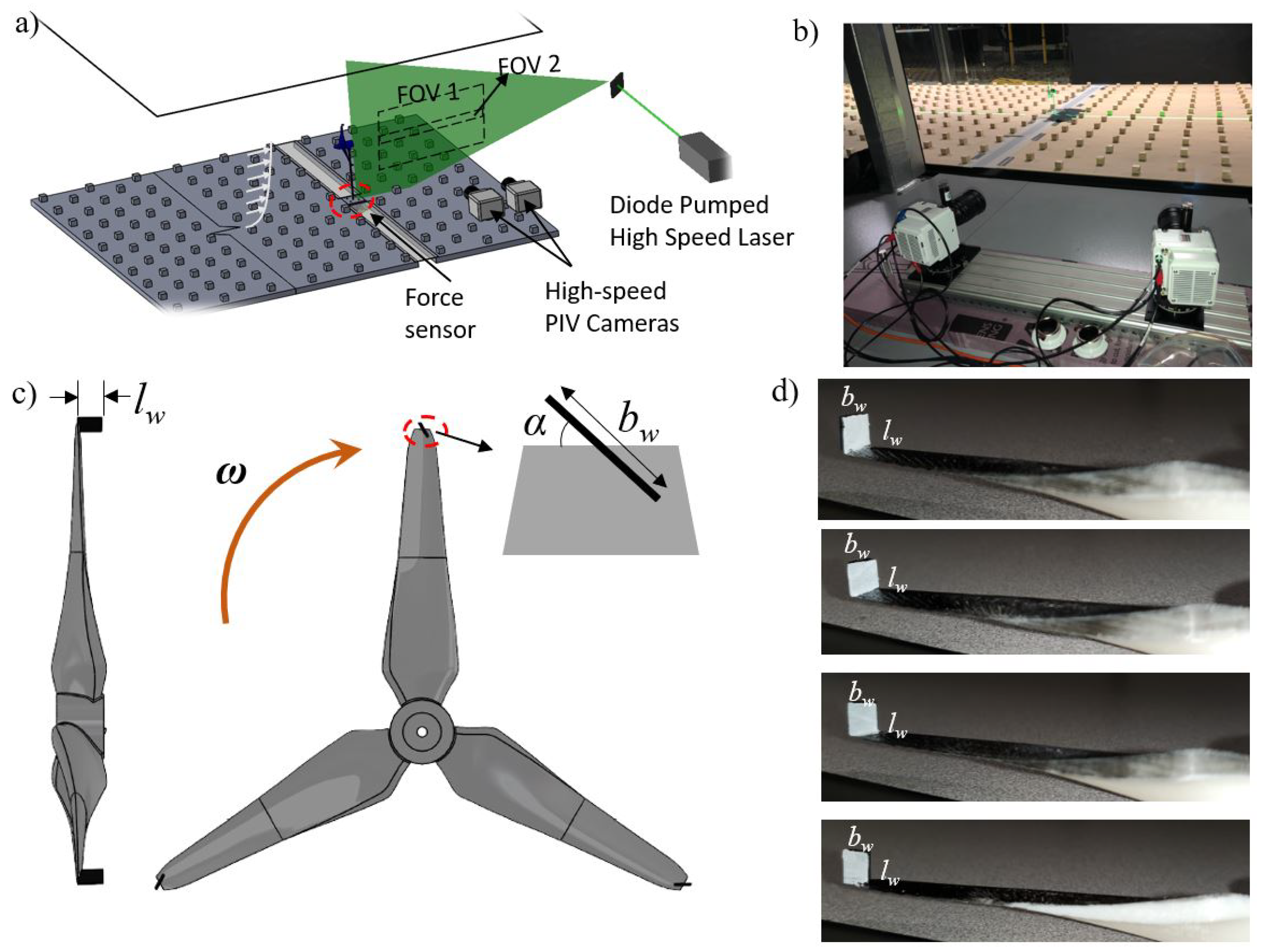




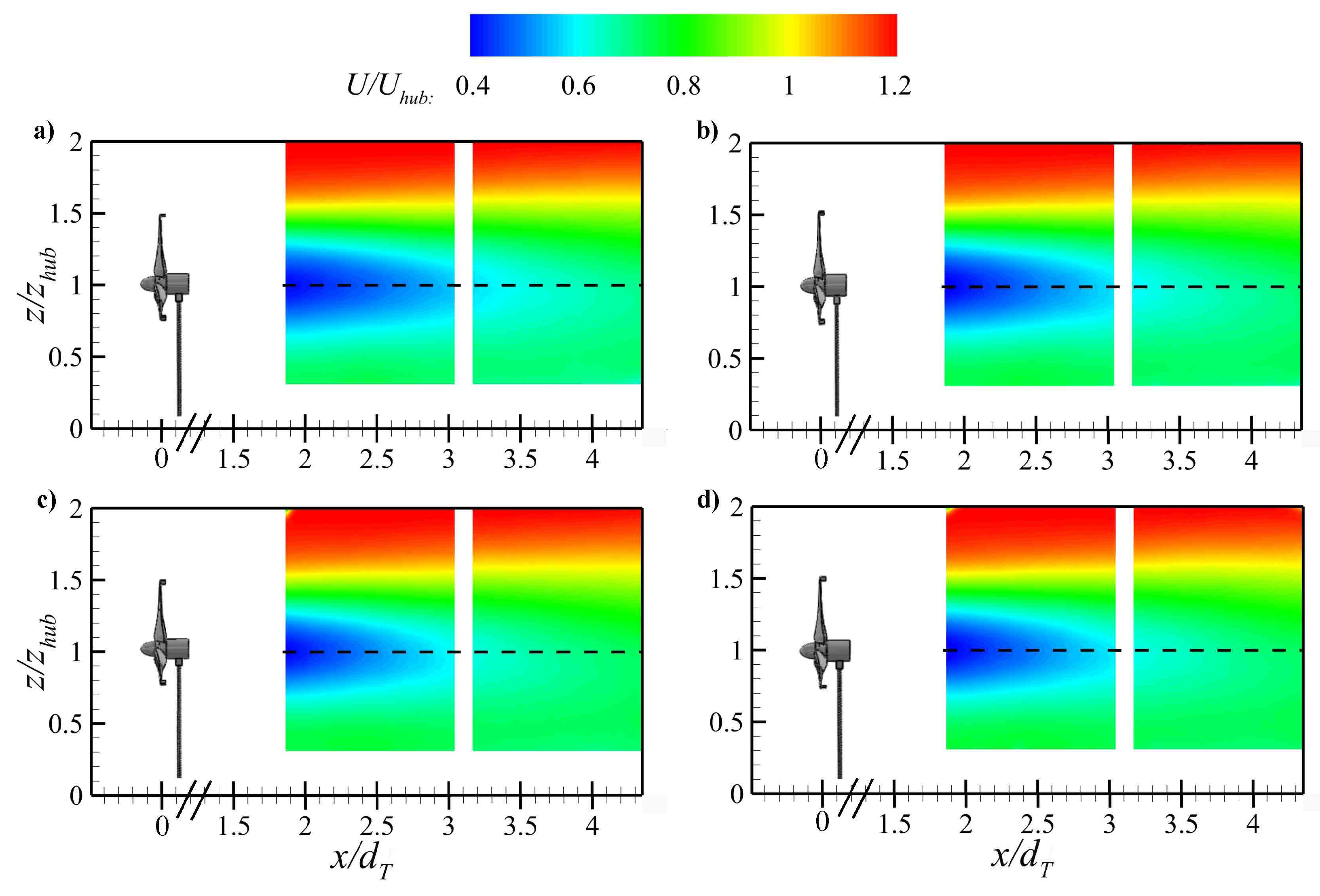
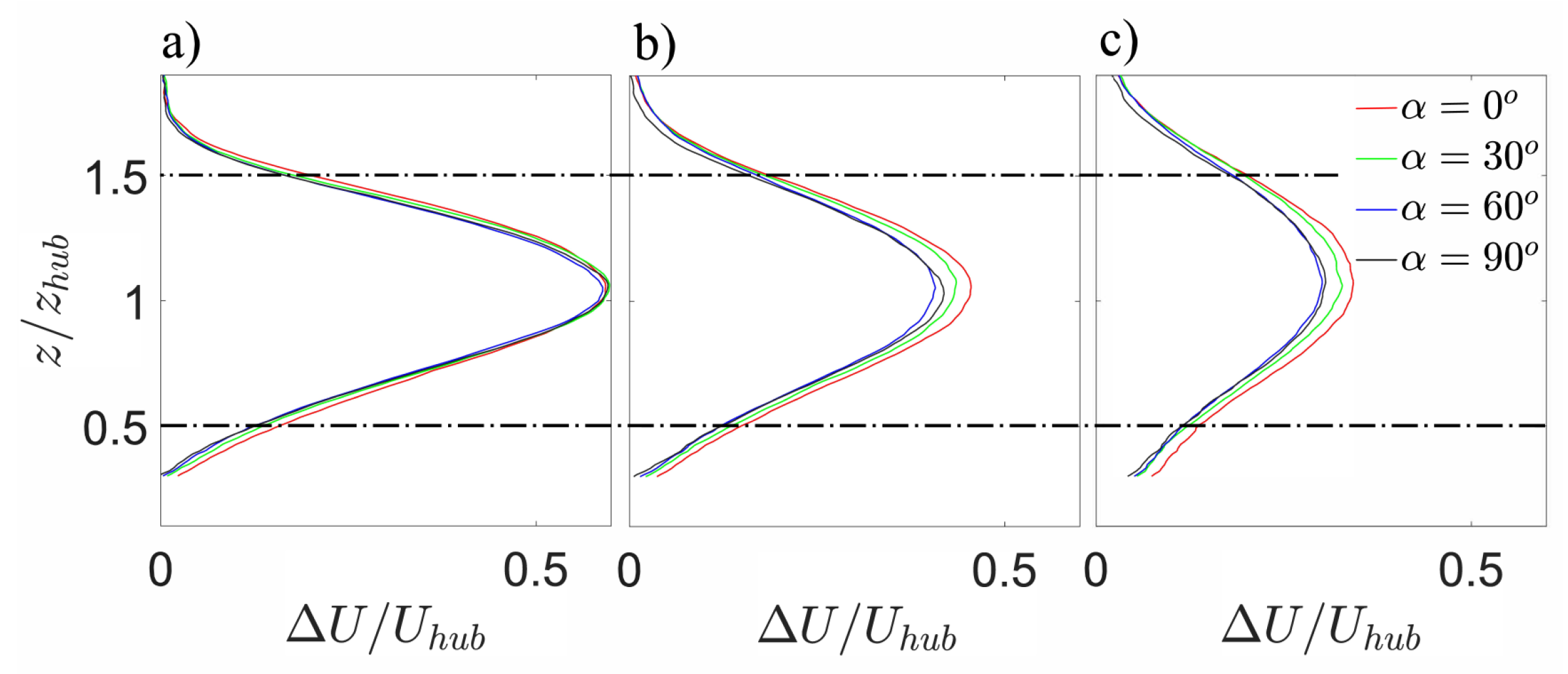

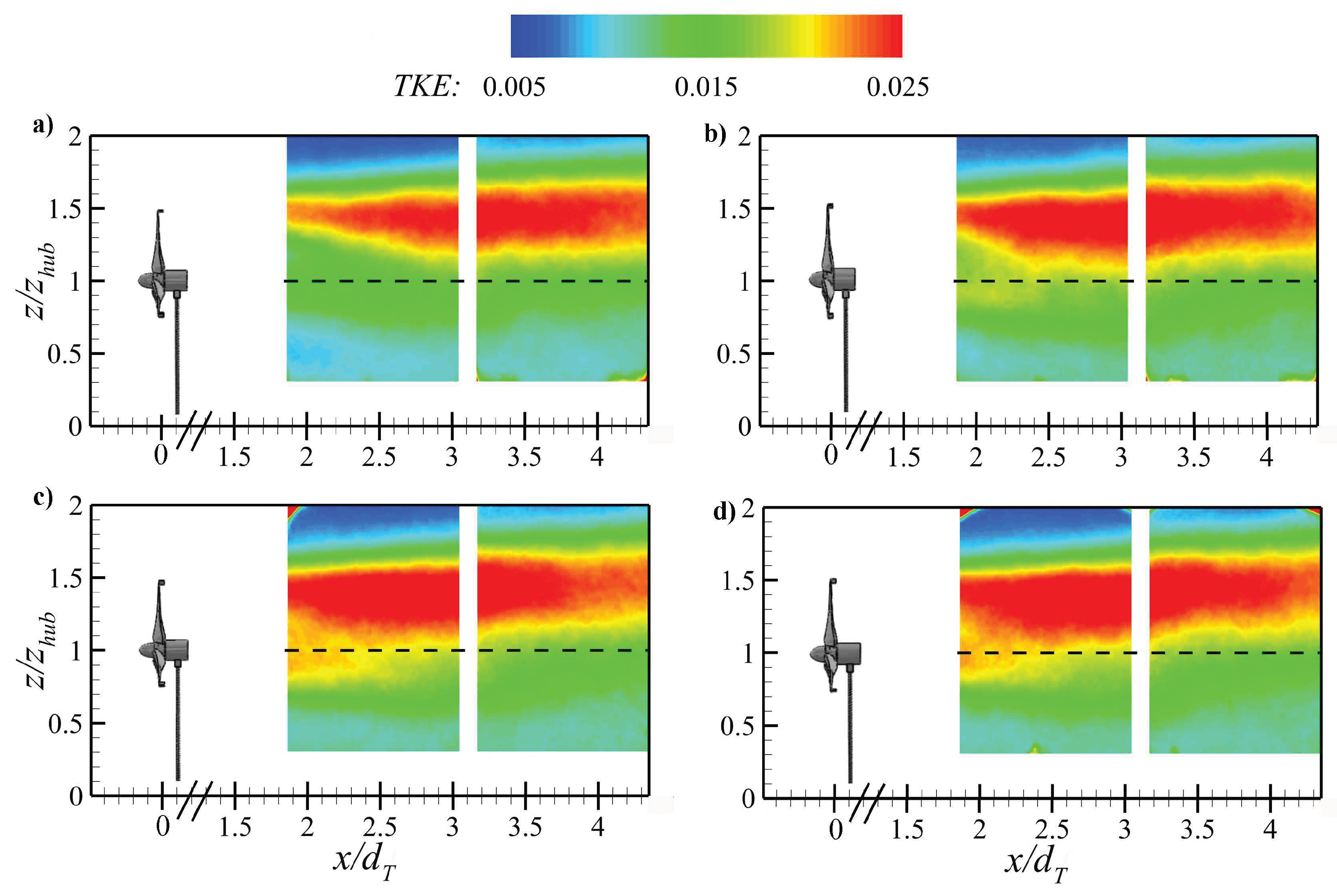
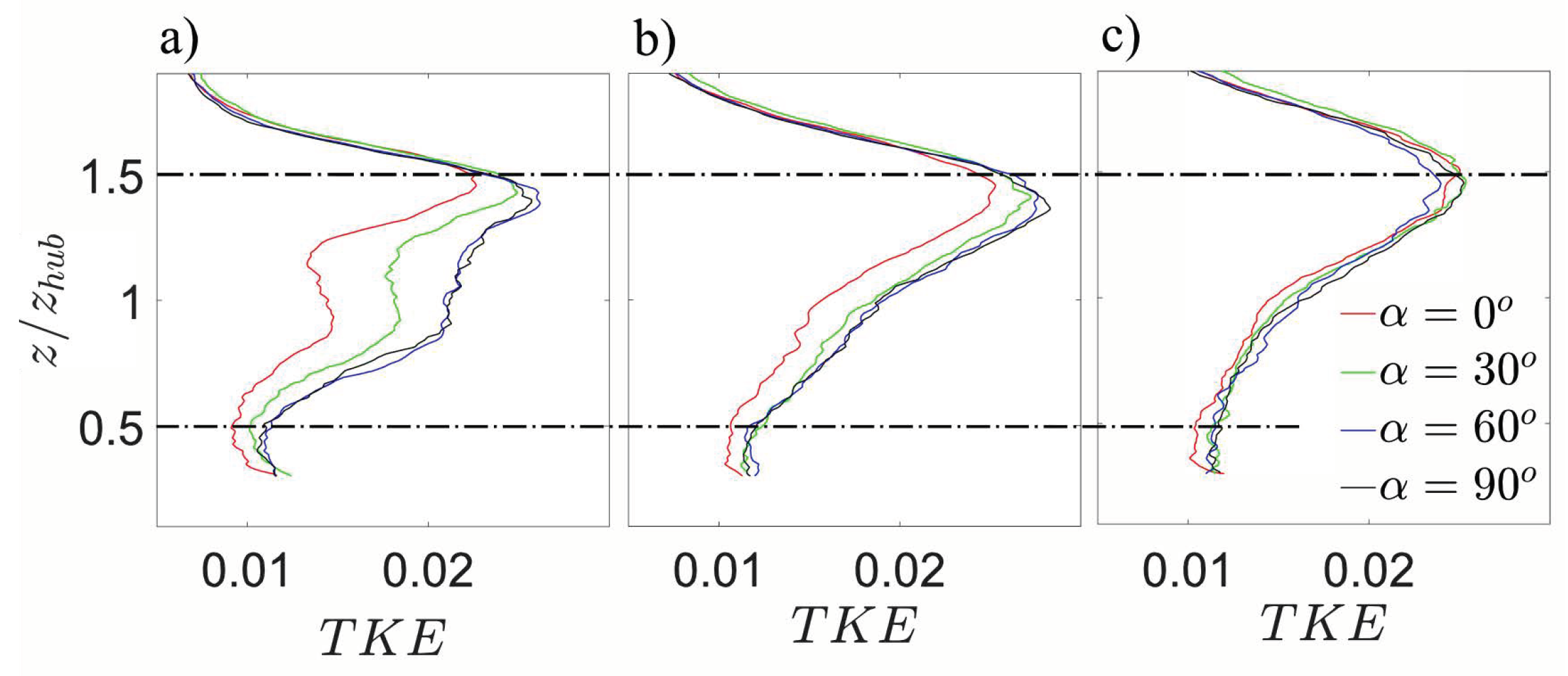
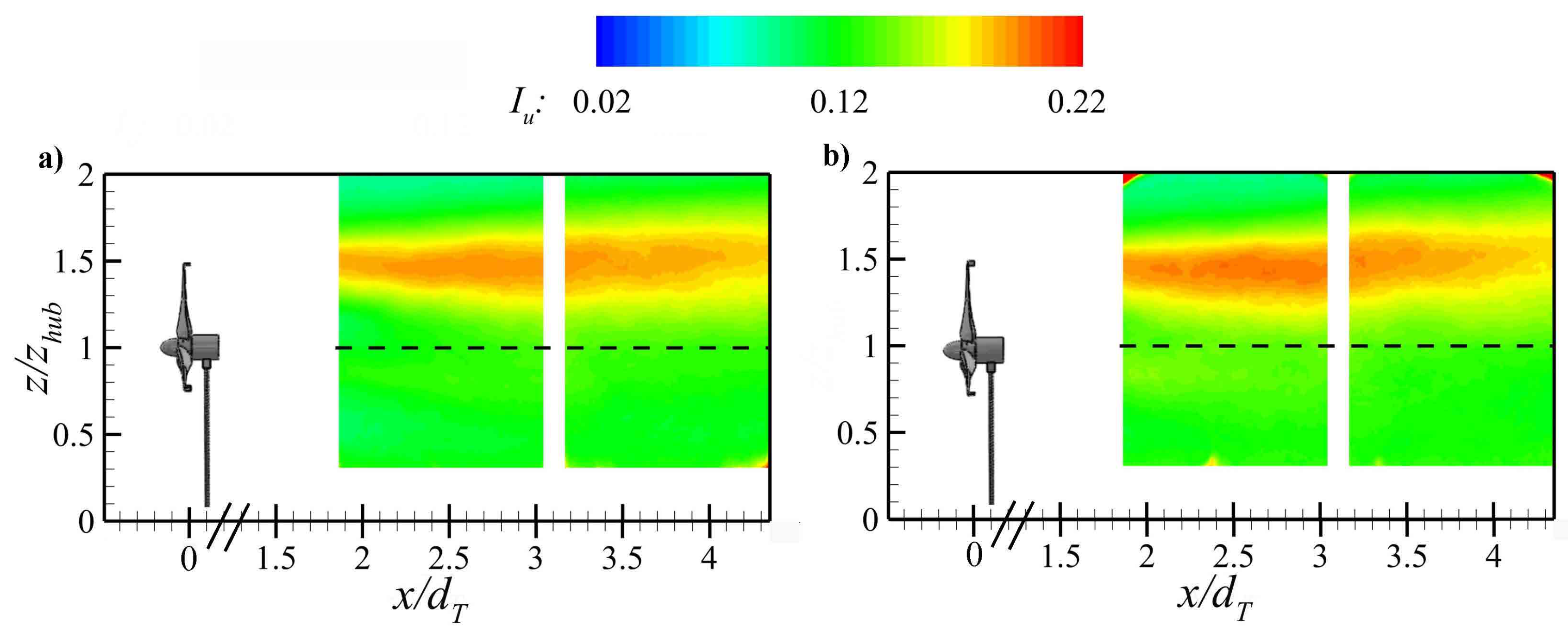
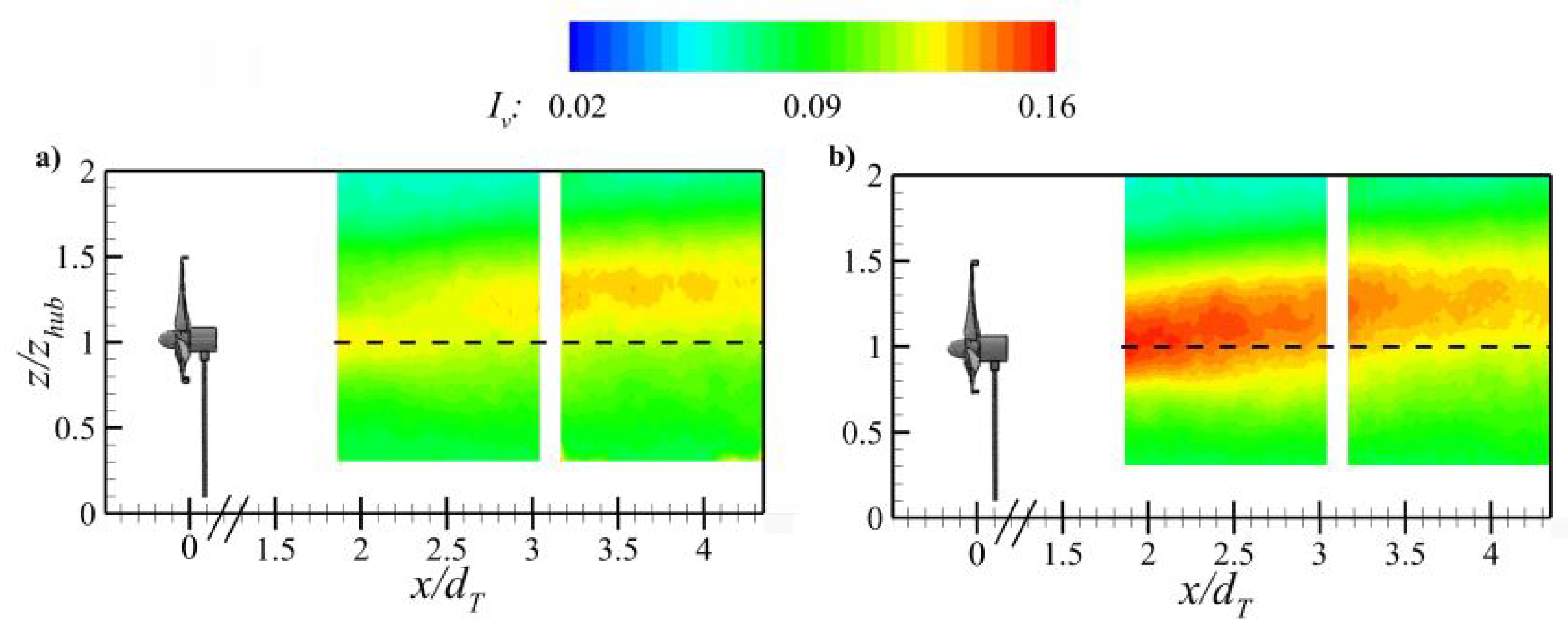


| (Mea) | 0.100 | 0.097 | 0.091 | 0.097 |
| (Mod) | 0.0893 | 0.0812 | 0.0724 | 0.0747 |
© 2020 by the authors. Licensee MDPI, Basel, Switzerland. This article is an open access article distributed under the terms and conditions of the Creative Commons Attribution (CC BY) license (http://creativecommons.org/licenses/by/4.0/).
Share and Cite
Aju, E.J.; Suresh, D.B.; Jin, Y. The Influence of Winglet Pitching on the Performance of a Model Wind Turbine: Aerodynamic Loads, Rotating Speed, and Wake Statistics. Energies 2020, 13, 5199. https://doi.org/10.3390/en13195199
Aju EJ, Suresh DB, Jin Y. The Influence of Winglet Pitching on the Performance of a Model Wind Turbine: Aerodynamic Loads, Rotating Speed, and Wake Statistics. Energies. 2020; 13(19):5199. https://doi.org/10.3390/en13195199
Chicago/Turabian StyleAju, Emmanuvel Joseph, Dhanush Bhamitipadi Suresh, and Yaqing Jin. 2020. "The Influence of Winglet Pitching on the Performance of a Model Wind Turbine: Aerodynamic Loads, Rotating Speed, and Wake Statistics" Energies 13, no. 19: 5199. https://doi.org/10.3390/en13195199
APA StyleAju, E. J., Suresh, D. B., & Jin, Y. (2020). The Influence of Winglet Pitching on the Performance of a Model Wind Turbine: Aerodynamic Loads, Rotating Speed, and Wake Statistics. Energies, 13(19), 5199. https://doi.org/10.3390/en13195199







